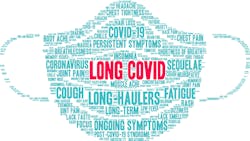New National Academies Report Calls for Adoption of Revised Definition for Long COVID
According to a June 11 news release, a new National Academies of Sciences, Engineering, and Medicine report says the federal government, state and local authorities, clinicians, medical societies and organizations, public health practitioners, employers, educators, and others should adopt a new definition for “Long COVID.”
Long COVID, according to the report, “is an infection-associated chronic condition that occurs after COVID-19 infection and is present for at least three months as a continuous, relapsing and remitting, or progressive disease state that affects one or more organ systems.”
No common definition for Long COVID has been agreed upon and the lack of a consensus definition is posing challenges to patients and providers alike.
The news release says that “Recognizing the need for broad input and an improved definition, the Administration for Strategic Preparedness and Response (ASPR) and the Office of the Assistant Secretary for Health (OASH) asked the National Academies to take up the issue of defining Long COVID. The committee that wrote the report engaged more than 1,300 participants in its activities, with a focus on interdisciplinary dialogue and the patient perspective.”
Further, “The report says the new Long COVID definition can be applied to many purposes — including clinical care and diagnosis; eligibility for health services, insurance coverage, disability benefits, and school or workplace accommodations; public health; social services; policymaking; epidemiology and surveillance; private and public research; and public awareness and education, especially for patients and their families and caregivers.”
“Long COVID is a devastatingly persistent result of the COVID-19 pandemic that the medical community has yet to fully address,” said Victor J. Dzau, president of the National Academy of Medicine. “Serving this patient population through better-coordinated care, more definitive diagnoses, and more efficient and streamlined research are important next steps for addressing its impact.”
Important features of Long COVID (LC) include:
- LC can follow asymptomatic, mild, or severe SARS-CoV-2 infection
- LC can be continuous from the time of acute SARS-CoV-2 infection or can be delayed in onset for weeks or months
- LC can affect children and adults, regardless of health, disability, or socioeconomic status, age, sex, gender, sexual orientation, race, ethnicity, or geographic location
- LC can exacerbate preexisting health conditions or present as new conditions
- LC can range from mild to severe—it can resolve over a period of months or can persist for months or years
- LC can be diagnosed on clinical grounds, as there is no biomarker currently available
- LC can impair individuals’ ability to work, attend school, take care of family, and care for themselves
Undertaken by the Committee on Examining the Working Definition for Long COVID, the study was sponsored by the Administration for Strategic Preparedness and Response and the Office of the Assistant Secretary for Health.

